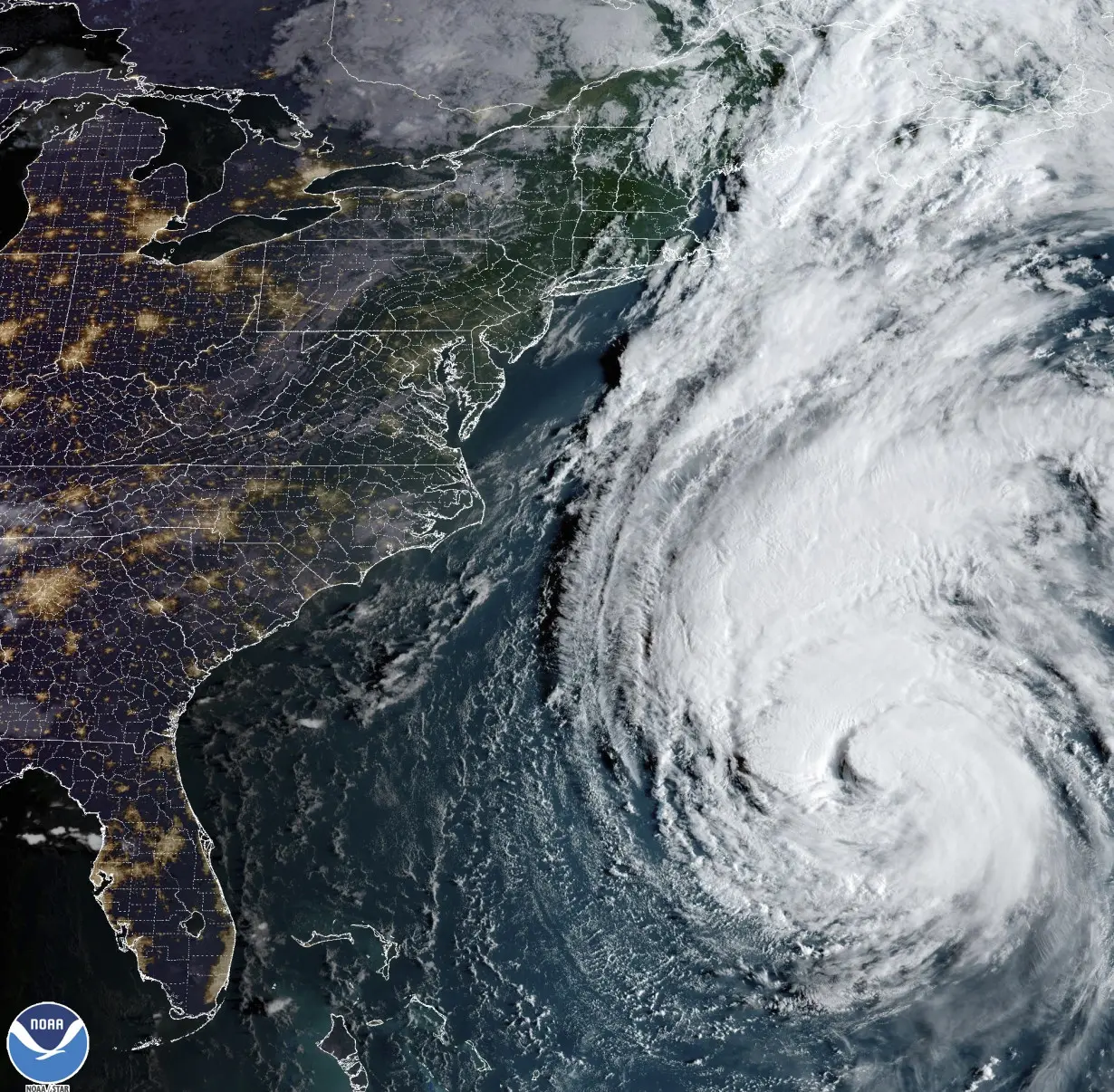PORTLAND, Maine (AP) — Days of wild weather that produced torrential rain, flooding, sinkholes and tornadoes in New England could be a prelude to something more dangerous lurking offshore — Hurricane Lee.
As the Category 1 system swirled southwest of Bermuda, Maine Gov. Janet Mills on Thursday declared a state of emergency, and the state was under its first hurricane watch in 15 years. The water-logged region prepared for 20-foot (6-meter) waves offshore and wind gusts up to 70 mph (112 kph), along with more rain.
Eastern Maine was under the hurricane watch while the rest of the state and an area extending south through Massachusetts were under a tropical storm warning. Powerful winds were expected to arrive late Friday in southern New England.
Although Lee did not contribute to the recent flooding, it threatened to exacerbate conditions in a region that is already much too wet.
The Coast Guard and emergency management agencies warned New England residents to be prepared, and utility companies brought in reinforcements to deal with power outages. At Boothbay Harbor Marina in Maine, the community came together to remove boats from the water to keep them out of harm's way.
“It’s a batten-down-the-hatches kind of day,” owner Kim Gillies said Thursday.
Similar scenes played out elsewhere, including at Kennebunkport Marina, where crews planned to take 100 boats out of the water, said Cathy Norton, marina manager.
Some people used the storm as an opportunity to put their boats into storage on land, bringing an abrupt end to the summer boating season, said John Lusty, owner of York Harbor Marine in York.
Commercial lobster fisherman Steve Train said fishermen have been sinking gear in deeper water to protect against storm damage. Fishing boats were also headed to the safety of harbors.
In Canada, residents of western Nova Scotia and southern New Brunswick were warned about the risk of power outages and flooding this weekend. A year ago, the remnants of Hurricane Fiona washed houses into the ocean, knocked out power to most of two provinces and swept a 72-year-old woman into the sea.
New Brunswick Minister of Public Safety Kris Austin urged residents to assemble a 72-hour safety kit that included batteries, water, food, medication and a radio.
In her emergency declaration, the Maine governor urged people to take the storm seriously and to make preparations. Mills, a Democrat, also asked President Joe Biden to issue a preemptive presidential disaster declaration to give the state access to federal resources.
Earlier in the week, the region saw 10 inches (25 centimeters) of rain over six hours. Tornado warnings were posted Wednesday for communities in Massachusetts and Rhode Island, and more heavy rain opened up sinkholes and brought devastating flooding to several areas.
The National Weather Service in Boston confirmed Thursday that damage to trees and power lines in Massachusetts, Rhode Island and Connecticut the day before was caused by four tornadoes.
Dozens of trees snapped or were uprooted by a twister in the town of Glocester, Rhode Island, and a structure used as a bus shelter was completely blown away, the weather service said. In Lincoln, Rhode Island, photos showed a home's roof damaged and the press box at the high school stadium tipped into the bleachers.
The three tornadoes in Connecticut and Rhode Island were categorized as EF-1, while the one in North Attleboro, Massachusetts, was an EF-0.
Thursday night, Lee was spinning 185 miles (300 kilometers) west of Bermuda, with maximum sustained winds of 85 mph (140 kph), according to the National Hurricane Center. It was traveling north on a path that could lead to landfall in Nova Scotia, possibly as a tropical storm, forecasters said.
The system threatened to bring a mixed bag of threats. The storm surge and waves could lash the coast, damaging structures and causing erosion; powerful wind gusts could knock down trees weakened by a wet summer; and rain could cause flash flooding in a region where the soil is already saturated, said Louise Fode, a National Weather Service meteorologist in Maine.
The state's eastern coast — known as the Down East region — and the coast of Nova Scotia and New Brunswick were expected to bear the brunt of the storm, though the track could shift before the system arrives, Fode said.
One thing working in the region's favor: The storm surge will not be accompanied by an astronomical high tide, helping to lower the risk, she said.
New England has experienced its share of flooding this summer, including a storm that dumped up to two months of rain in two days in Vermont in July, resulting in two deaths. Scientists are finding that storms around the world are forming in a warmer atmosphere, making extreme rainfall more frequent.
Massachusetts Gov. Maura Healey issued a state of emergency late Tuesday following “catastrophic flash flooding and property damage” in two counties and other communities. The torrential downpour in a six-hour period was a “200-year event,” said Matthew Belk, a meteorologist with the National Weather Service in Boston.
The state is monitoring the conditions of dams, the governor said, and she urged residents to stay off the roads when ordered.
The rain created several sinkholes in Leominster, Massachusetts, including one at a car dealership where several vehicles were swallowed up. In Providence, Rhode Island, downpours flooded a parking lot and parts of a shopping mall. Firefighters used inflatable boats to rescue more than two dozen people stranded in cars.
In Maine, the last time a hurricane watch was declared was in 2008, for Hurricane Kyle, but residents are accustomed to rough weather. Lee's projected wind, rain and surf are akin to a powerful Nor'easter, and Mainers are familiar with those.
The Portland Sea Dogs, a minor league baseball team, moved its fan appreciation day to Friday because of the weather forecast. But the club had no plans to cancel its game on Saturday despite the storm.
___
Associated Press journalists Rob Gillies in Toronto and Robert F. Bukaty in York, Maine, contributed to this report.

 Fed's Kashkari says broad-based US deportations could disrupt labor for some businesses
Fed's Kashkari says broad-based US deportations could disrupt labor for some businesses
 'Heretic' and Hugh Grant debut with $11 million, but 'Venom: The Last Dance' tops box office again
'Heretic' and Hugh Grant debut with $11 million, but 'Venom: The Last Dance' tops box office again
 Veterans face challenges starting small businesses but there are plenty of resources to help
Veterans face challenges starting small businesses but there are plenty of resources to help
 Trump in phone call advised Putin not to escalate in Ukraine - Washington Post
Trump in phone call advised Putin not to escalate in Ukraine - Washington Post
 The Taliban will attend a UN climate conference for the 1st time
The Taliban will attend a UN climate conference for the 1st time
 No reason not to cut rates in Dec as of now, ECB's Holzmann tells paper
No reason not to cut rates in Dec as of now, ECB's Holzmann tells paper
 Chiefs block Broncos' potential winner as time expires, hold on for 16-14 win to remain perfect
Chiefs block Broncos' potential winner as time expires, hold on for 16-14 win to remain perfect
 Judith Jamison, influential dancer and choreographer, dies at 81
Judith Jamison, influential dancer and choreographer, dies at 81
 Tennis Channel takes Jon Wertheim off the air for comment about Wimbledon champ Barbora Krejcikova
Tennis Channel takes Jon Wertheim off the air for comment about Wimbledon champ Barbora Krejcikova

